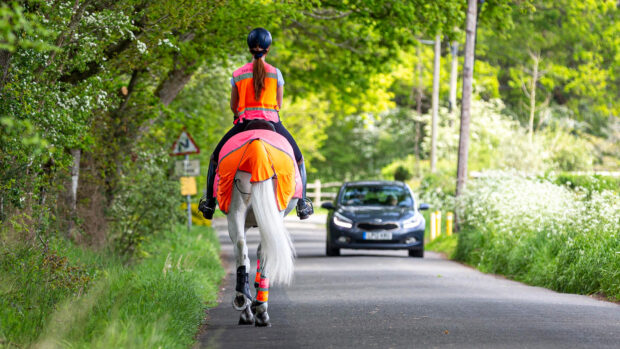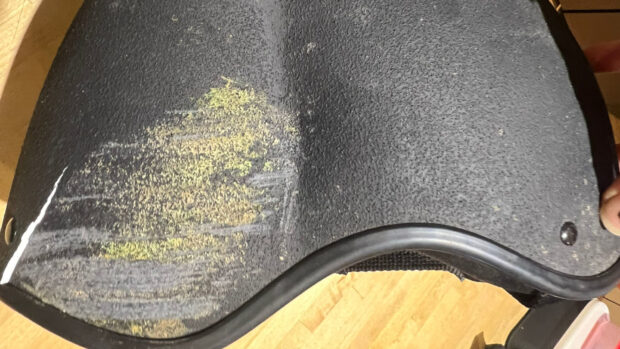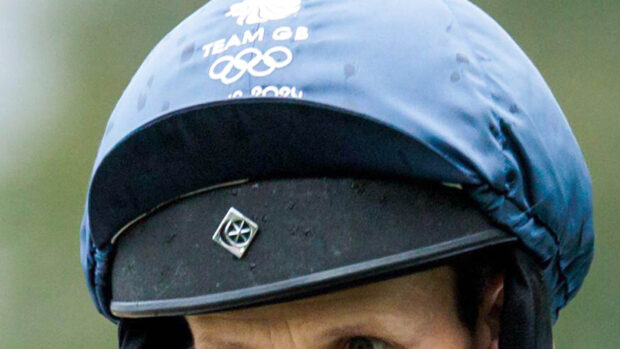Claire Monier-Williams was enjoying a hack with her daughter at the top of Winchester Hill, an ancient wind-blown hill-fort in Hampshire, when their horses bolted, spooked by the sound of nearby motorbikes on a parallel lane. Claire’s horse fell and she landed badly.
Realising what had happened, the bikers returned and, although Claire had her own phone, they used their mobiles to call an ambulance, with Claire giving directions. The first responder arrived and within half an hour Claire was in an ambulance. She had crushed one of the vertebra in her back. That was in July — she now cannot ride again.
Every day, riders find themselves in lonely places like Winchester Hill — it’s one of the charms of riding. But the risk of unexpected injury is always there. Claire’s story demonstrates how vital it is to be prepared.
“I always make my daughter carry a phone and tell me where she is,” she says. “Now she also rides with body protection. My accident was just bad luck, but as a rider you take a risk every time you go out.”
Know your exact location
That risk increases greatly if a rider has a fall and doesn’t know their exact location.
“Horse riders need to be a lot more aware of where they are,” says Tommy Abdy-Collins, a pilot with the Thames Valley and Chiltern Air Ambulance. He speaks from experience.
Equestrian incidents account for 11% of calls answered by Thames Valley and Chiltern Air Ambulance, and Mr Abdy-Collins finds it “frustrating when we are unable to identify the scene, having got to the area as quickly as we could, because of poor directions given to the emergency services”.
He advises riders to think how they are going to give directions before dialling 999.
“Telling us: ‘I am in a field by a wood and can see Didcot Power Station in the distance,’ is not much use. If you know which farm you are on, we need to know where you are relative to the farm, even if it is only, ‘I am three fields away and at the side of a ploughed/grass/stubble field.’ If you are hunting, say so.”
After a bad fall hunting, Jenny Rivers decided to get together with her fellow Oakley hunt supporters and do a Calendar Girls-style calendar to raise funds for the Thames Valley and Chiltern Air Ambulance.
“They are so invaluable to us, they can get to us riders in places other ambulances can’t,” says Jenny Rivers.
Her co-organiser, Lady Lydia Thompson helped give instructions to the air ambulance and kept horses out of the way when her groom fell off in a ditch last year out hunting and hurt her back.
“We were in the middle of nowhere and the normal ambulance couldn’t reach her,” says Lady Thompson. “It is very important to give the air ambulance specific instructions and details of the accident.”
Tony Stevens, a pilot with the County Air Ambulance, based at RAF Cosford, near Wolverhampton, warns riders to keep horses clear of an accident and to send one person out to wave a jacket, or if possible something fluorescent, a large white sheet or something similar. When the helicopter is in sight, he warns: “Don’t try to marshal us in.”
If the call out is to a competition, he recommends organisers should have start and finish grid references; and if the event is at an equestrian centre, the grid references of the centre and particular fields and courses should be prominently displayed in case of an emergency. Mr Stevens has had cases when the caller has not informed the air ambulance that the patient is lying in an indoor school.
“Riders are usually off the beaten track,” says Chris Cooper, the first response manager at Great Western Ambulance Services. He agrees one of the biggest problems is that riders often don’t know what information to give about their location or injury.
Get involved
Mr Cooper would like to see more people in riding establishments contact their local ambulance service and become voluntary local responders. Responders are often the first medically trained people on the scene and can let the emergency services know what type of help — conventional ambulance or air ambulance — is needed to get the patient to hospital. He hopes that Jennie Williams, the service’s first equine responder, will enable the ambulance service to meet that challenge.
Jennie is an AI and teaches around north Somerset, so is ideally placed to give the vital directions that might be all it takes to stop an accident developing into an emergency.
To qualify as a responder, 27-year-old Jennie spent three days in a classroom receiving her medical training and then went on four “ride alongs” on an ambulance and attended 30-40 medical cases under supervision. Her main advice to all riders is simple: never go out without a phone, wear fluorescents and a back protector and, if you’re leaving the yard, always tell someone where you are going. After all, a phone is no good to you if you’ve been knocked out.
“You don’t want to take the fun out of riding, but you want to be safe,” she says.
“We have a dozen life-threatening emergencies linked to rural pursuits each week in the Mendip Hills area,” says Mr Cooper, who is in charge of 80 responders. “I hope Jennie will make an impact on that.”
Is global positioning the future?
At Brenfield Farm, a pony trekking centre in Argyll on the west coast of Scotland, leaders carry GPS (global positioning system) receivers and Ordnance Survey maps and all riders have to sign a form with emergency numbers, even for an hour’s hack.
Chris Hall, who manages the farm, says he wouldn’t be surprised if a mobile phone soon becomes an insurance requirement for clients at all trekking centres.
GPS receivers now weigh as little as 6oz, are waterproof and cost around £80. If set properly, they will give your exact OS co-ordinates. Slip one of those in your pocket and you will be able to tell any emergency service precisely where you are. But please make sure it is a real emergency. The air ambulance is supported by charitable donations and it costs £1,000 an hour to keep one flying. Call them out for a sprained ankle and you will not only be wasting their time and money — you may also be depriving another person of a vital service when they might really need it.
Advice for a safe ride
1. Take a mobile phone
2. Make sure someone knows where and for how long you are going for a ride
3. Consider wearing a back protector
4. Wear fluorescents
5. If going somewhere totally new, take an OS map of the area
6. If your horse is liable to take off without you, put a dog tag on the saddle with your name and address on
7. If you fall off and need emergency help, try and give as much information about where you are as possible
8. If running a livery yard, keep an OS map by the phone and write down the grid reference of the yard on a card
9. At competitions have an emergency plan that is known to everyone involved



